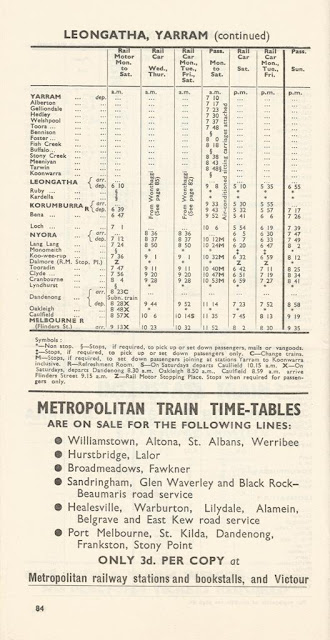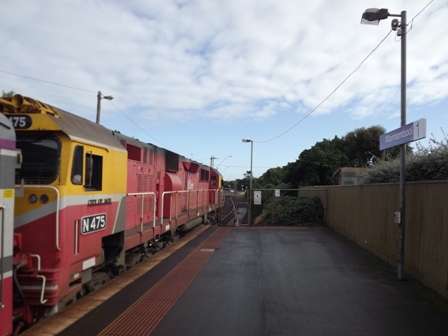Foster is a small country town with a population just a little over 1,000 people located in the south east of Victoria. If you'd never heard of the place before, then don't worry, neither had I until my parents told me we were moving to Foster late in 1986. For a young railway enthusiast of just 14 years of age growing up north of Sydney in the Gosford suburb of Point Clare, leaving our home close to the busy NSW Main North Line to move to Foster was the equivalent of moving to a railway Siberia. As it turned out, I arrived in time to witness the final years of operation on the South Gippsland Line east of Leongatha.
 |
| The once-weekly Barry Beach oil train passing through Foster in 1989. |
Foster Railway Station stood 174 km north east of Melbourne's
Flinders Street Station and first opened in 1892. The Great Southern Railway as it was once known continued east in 1921 to Yarram, a total distance of 220 km from Flinders Street Station, and from 1923 to 1953 included a 39 km branch line linking Yarram with the towns of Port Albert and Woodside. Passenger services through Foster had already been discontinued in June 1981, so by October 1987 when the line to Yarram was closed beyond Welshpool, only a sporadic weekly freight train remained, hauling superphosphate to various locations east of Leongatha, and oil tankers to Barry Beach to service the oil rigs in Bass Strait.
 |
| The Barry Beach oil train with empty VTQY wagons passing through Foster in 1989. |
For a budding train photographer, my four years spent living in Foster were hardly a railway enthusiast's delight. Still too young to hold a license, my train watching days were confined to wherever my bike would take me. Often while on school holidays, I would hear a distant locomotive horn early on a Wednesday morning, and know that I had just enough time to cycle the 2 miles out of town to where the railway station once stood to watch the weekly freight train pass through.
 |
| Foster's railway station platform was already disappearing when I photographed it in 1989. |
Sometime between 1986 and 1987, Foster's railway station building was removed and the platform reduced to an overgrown motley collection of shrubbery trying desperately to hide the fact that a railway station once stood there at all. In the above photo taken in 1989, you can still make out the track arrangement in the goods yard and the track leading to the turntable that I've shown at the top of this post. Foster once had a goods shed and a 4 track yard, 1 track for the platform road, 1 used as a passing loop and the other 2 for handing freight wagons. By 1989, the passing loop had been removed, and by 1991 the other 2 tracks were cut back to the double slip point on the turntable approach. I still remember the sight and sound of the last steam train to Yarram passing through Foster on Saturday 24th October 1987. Although I only found out about it at the last minute and as was the custom in a small country town on a Saturday morning, all the shops shut at 12 midday so I was unable to buy any film for my camera.
 |
| Taken in 1989, the old water tower was still used for steam excursions on the line. |
My time in Foster was cruel like that. Although to be perfectly honest, my 4 years living there gave me a new found appreciation for Australia's disappearing railway scene. It seems we were all at one time guilty of complaining about travelling by train in draughty red carriages, that we never stopped to pay attention to something as utilitarian as a worn-out weatherboard railway station and a rusting water tank until it was gone.
 |
| This up home semaphore signal guarded the approach to Foster Station. Photo 1989. |
While in Foster, I worked at the local Murray-Goulburn farm and hardware supply store directly across the road from the railway station. The building was at one-time the local Foster Butter Factory, no doubt built to be in close proximity to the railway line. Wednesdays were my favourite days to be rostered on during school holidays, as I'd see the Barry Beach oil train pass by anywhere between 7.30 am and 9.00 am, then a couple of hours later it would pass by once more, hauling empty VTQY or VTQF distillate wagons back to Korrumburra. Sometimes the locos would run light engine one way to collect the empty fuel wagons, sometimes it would be the other way around. Usually the train would also attach any empty superphosphate wagons at Fish Creek and Buffalo on the return trip to Korrumburra. On the rare occasion, this would be done on the way to the Barry Beach marine terminal, providing the rare sight of a mixed freight train running through Foster.
 |
| The final July 1980 Melbourne - Yarram train timetable. A year later passenger services ceased beyond Leongatha. |
Thumbing through my collection of old Victorian Railways timetables, I came across the above train timetable for passenger services on the South Gippsland Line to Leongatha and Yarram. The July 1980 timetable would be the final train timetable for passenger services beyond Leongatha, and all of the railway stations shown on this timetable were closed less than a year later on 6th June 1981. While the 1964-65 timetable shown below, includes stops for long forgotten stations between Leongatha and Yarram such as Koonwarra, Tarwin, Stony Creek, Bennison, Hedley and Gelliondale, all of which were believed to have closed by 31 July 1976.
 |
| This timetable scan is also from my collection, showing 1964-65 Yarram train services. |
 |
| This 1964-64 VR railway timetable shows long forgotten stations on the South Gippsland Line. |
It was a far cry from the days when a daily mixed local train ran between Melbourne and Yarram however, and to have lived in Foster at a time when R class steam locomotives were being turned on the turntable would have been something else. But sometimes those are the cards that life deals you, and my time in Foster was that of a high school student writing letters to the editor of the local newspaper imploring the government to reinstate passenger trains on the line east of Leongatha. Thankfully the local Foster Mirror indulged me with my passion. Fortunately that passion didn't die away with the slow death of the line beyond Leongatha. By the time I got my drivers license in 1990, I finally got to experience bouncing across the level crossing in my car. By January 1991 I had bounced my way out of town altogether.
 |
| The trestle bridge across Stockyard Creek in Foster is one of the few reminders of Foster's railway past. Photo taken 1991. |
The line east of Leongatha was finally closed on 30th June 1992 and the rails between Leongatha and Welshpool were sadly ripped up. The following year on 24th July 1993, the remaining section of the South Gippsland Line east of the Melbourne suburb of Cranbourne also closed, bringing to an end just over a century of railway history. Fortunately, the corridor of track east of Leongatha was converted into The Great Southern Rail Trail, and today it is possible to bike or hike the rail trail through Foster along the 73 km former railway line as far as Port Welshpool. There are many books and other resources available online through the Rail Trails website, and thanks to the internet I've been able to discover some amazing collections of railway photos such as the South & West Gippsland Transport Group's Facebook page featuring vintage 1970's photos of trains passing through Foster and the Hoddle Range.
Yet for all the cruel luck I seemed to encounter when trying to photograph trains during the four years I lived in Foster, I was able to include two scenes of Foster, (and many more of the South Gippsland Line) in my book
30 Years Chasing Trains. Published as a photographic memoir of a train chaser, Foster became my catalyst to better myself as a both a writer and railway photographer. By the time I'd left town, I had won the Foster & District High School's Writing Workshop Award twice, bothered the local newspaper with numerous Letters to the Editor and even won my local High School's Senior Sportsman of the Year Award, (probably on account of my fitness from cycling two miles at record speed in an attempt to see the weekly train pass through town), all because of trains. Perhaps more strangely however, Foster also became the place where I would meet my wife of almost 24 years, and Denise is still at my side today whenever I set off on another railway adventure. So with only four more Railway Reminiscing blog posts to follow, I couldn't help but share what in reality was a rather unexciting rail tale of a railway line that once went to a quiet, unassuming location in South Gippsland. A tiny place that actually turned out to be a huge turning point in my life. A little place called Foster.

Available now through my Books page
See also;
Flinders Street: Melbourne's grand old station
























